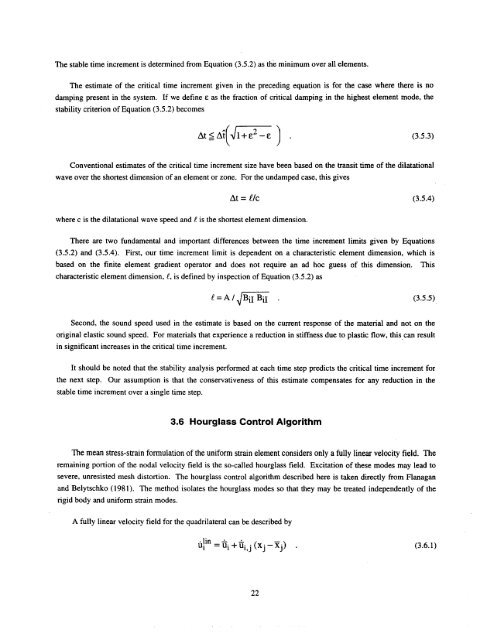II II II II II I - Waste Isolation Pilot Plant - U.S. Department of Energy
II II II II II I - Waste Isolation Pilot Plant - U.S. Department of Energy
II II II II II I - Waste Isolation Pilot Plant - U.S. Department of Energy
- No tags were found...
You also want an ePaper? Increase the reach of your titles
YUMPU automatically turns print PDFs into web optimized ePapers that Google loves.
The stable time increment is determined from Equation (3.5.2) as the minimum over all elements.<br />
The estimate <strong>of</strong> the critical time increment given in the preceding equation is for the case where there is no<br />
damping present in the system. If we define & as the fraction <strong>of</strong> critical damping in the highest element mode, the<br />
stability criterion <strong>of</strong> Equation (3.5.2) becomes<br />
AG.(- ) . (3.5.3)<br />
Conventional estimates <strong>of</strong> the critical time increment size have been based on the transit time <strong>of</strong> the dilatational<br />
wave over the shortest dimension <strong>of</strong> an element or zone. For the undamped case, this gives<br />
At= ~/C (3.5.4)<br />
where c is the dilatational wave speed and t is the shortest element dimension.<br />
There are two fundamental and important differences between the time increment limits given by Equations<br />
(3.5.2) and (3.5.4). First, our time increment limit is dependent on a characteristic element dimension, which is<br />
based on the finite element gradient operator and does not require an ad hoc guess <strong>of</strong> this dimension. This<br />
characteristic element dimension, t, is defined by inspection <strong>of</strong> Equation (3.5.2) as<br />
(3.5.5)<br />
Second, the sound speed used in the estimate is based on the current response <strong>of</strong> the material and not on the<br />
original elastic sound speed. For materials that experience a reduction in stiffness due to plastic flow, this can result<br />
in significant increases in the critical time increment.<br />
It should be noted that the stability analysis performed at each time step predicts the critical time increment for<br />
the next step. Our assumption is that the conservativeness <strong>of</strong> this estimate compensates for any reduction in the<br />
stable time increment over a single time step.<br />
3.6 Hourglass Control Algorithm<br />
The mean stress-strain formulation <strong>of</strong> the uniform strain element considers only a fully linear velocity field. The<br />
remaining portion <strong>of</strong> the nodal velocity field is the so-called hourglass field. Excitation <strong>of</strong> these modes may lead to<br />
severe, unresisted mesh distortion. The hourglass control algorithm described here is taken directly from Ftanagan<br />
and Belytschko (1981). The method isolates the hourglass modes so that they may be treated independently <strong>of</strong> the<br />
rigid body and uniform strain modes.<br />
A fully linear velocity field for the quadrilateral can be described by<br />
li~in=iii+iii,j(Xj ‘~j) . (3.6.1)<br />
22
















